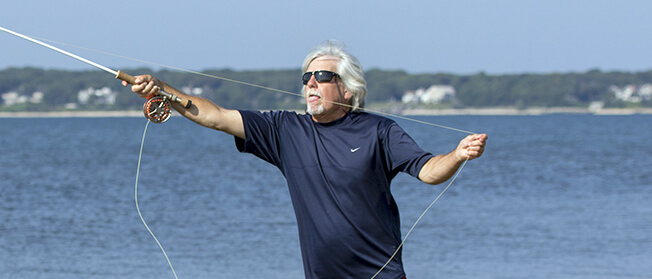by Mark Sedotti
Got to make a quick presentation behind you? Wind blowing the line into you? Have an obstacle, rock, boat engine, or part of that boat impeding your forward cast? If so, perhaps the easiest thing to do is to present on the backcast. Sometimes all you have to do is turn around and present! It’s easy, it’s quick, and you can be very accurate and powerful with the cast as well.
Presenting on the backcast is something I’ve been doing for decades, and you see it even more frequently nowadays, especially in salt water and with anglers who are trout fishing with streamers. The reason is because it’s oh so effective! In fact, over the years I’ve probably made as many presentations with my backcast as I have with my forward cast for all of my Northeast saltwater fishing.
For short casts, all you have to do is present on your normal backcast. That’s it! But don’t overdo the casting arc at the end when you unload, which is the natural tendency. This will only open up your casting loop, robbing the cast of necessary control and energy.
Turn That Reel and Witness the Magic!
What can really make that backcast effective is turning your reel out to the side (about 90 degrees). To do this, rotate your wrist. For the right-handed caster the motion is like twisting a doorknob counterclockwise. During the cast you might only do this when you present. If you want to look at your target behind you, you’ll have to do it on some false casts as well. The movement will allow you to make great backcast presentations at all distances. It works wonders as it allows you to naturally use your forearm, upper arm, shoulder, and the rest of your body in the cast. It also allows you to look both forward and behind you at any time during the casting sequence. By rotating your wrist, you support the rod butt with your forearm, giving you more leverage for easier distance, control, and accuracy (especially on longer casts). To deliver a long backcast, it’s very important to lead with the reel during the stroke. That is, the rod angles behind the hand for the entire stroke except at the finish, as you extend on the cast. This adds even more power and accuracy to the presentation.
Extension
For a short cast you don’t need to extend much or use much of your body. But the farther you want to cast, the more you extend; and the more you extend, the more you’ll need to engage the forearm, shoulder, back (latissimus dorsi) and hips into the cast. For a very long backcast you may incorporate all of these, including a weight shift and body lean.
Let’s Go Through a Casting Sequence
Begin with traditional false casts. Next, turn the reel out to the side and false cast this way to view the target.
Lead with the reel and extend to load the rod more and handle more line in air. The more you extend, the more arm, shoulder, hip, and body you’ll include. (For flats fishing and quiet presentations you’ll have to do this with great control.)
Remember that loading the rod on the backcast is a pulling movement. You actually pull the rod hand with the forearm, elbow, shoulder, and lat as you load the rod. For that longer cast (and longer extension) you’ll even twist some at the waist. For a shorter cast there’s less pronounced movement (perhaps using only the hand and forearm, with a little elbow). Once you get the reel past your body on the stroke (for a long extension and cast), you’re no longer pulling with your body; instead, you’re relying on the continued pulling and acceleration of your forearm combined with the momentum you’ve already built up.
Accelerate through the extension to load the rod, and then use a short wrist arc at the end of the stroke combined with a smooth and succinct forearm stop. You’ll unload the rod with this very short movement. An alternative is to use no wrist at all and simply stop the forearm suddenly and smoothly.

Your Rod Hand During the Stroke
Move your rod hand in a straight line to the target for the entire stroke. Remember, the rod tip follows the hand. Lead with the reel as you do this, and at the end of the stroke make that short stop. You’ll throw a straight line with a tight loop right where you want the fly to go. You actually want to aim that fly to a point a little above the target, and let the fly “fall in.”
You’re guaranteed accuracy on a long cast with this backcast because the rod butt is pressed into the underside of your forearm by the pressure of the bent rod only, and the only way the butt can stay in that position during the stroke is if your hand moves in a straight line. If is doesn’t move in a straight line, that butt will slip off to one side or the other and the cast will immediately fall apart. It works only by moving in a straight line.
In the end, this is an incredibly powerful, accurate, and useful presentation cast that’s good for fishing at all distances and under countless circumstances. It’s one great weapon to have in your saltwater fly fishing arsenal!

Rotating your wrist places the butt of the rod in the middle of your forearm.
Don’t press it in there. It’s very important that you allow the load on rod
(that is, the bend) during the backcast stroke to press it there naturally.
Bio: Mark Sedotti is renowned as both a distance fly caster and innovative fly tier. You can contact him regarding private instruction as well as clinics and classes at msedotti@hotmail.com.



